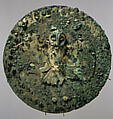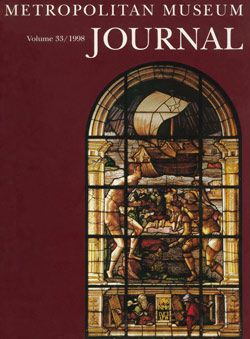Shield with owl figure
Not on view
This gilded and silvered copper disk, featuring a nearly three-dimensional owl at it center, reveals the highly sophisticated metallurgical technologies developed by Moche artisans on Peru’s North Coast in the first millennium AD. The disk is among the most complex of its type, containing both silvered and gilded copper and five different and conjoined metal pieces (excluding the numerous dangles and wires) (Schorsch, 1998). The body of the gilded owl with outstretched wings and grasping talons is attached to a silvered copper disk by small tabs that go through to the back and are bent to prevent slippage. The wings, however, are not attached allowing them to “flutter” as the object was moved during use. The owl’s head, with its inlaid eyes of shell and turquoise, was made separately and does not directly attach to the backing. Instead, a small copper rod extends from the head into the bird’s body. This would have permitted the head to rotate from side to side when the object was moved. The circumferential surface of the disk is covered with a rim of gilded copper, cut from a separate sheet, and held in place by the wires that carry the dangles as well as small tabs. The dangles were also gilded copper. One can imagine the spectacular effect of light reflecting off of the contrasting silver and gold elements of this object as well as the movement of the head, wings and dangles. On the figure’s left side, as well as on the lower left of the owl’s body, there are remnants of a beaded textile that was once adjacent to the disk.
The function of disks such the present example is unclear. They may have served as shield frontals, attached to a cane backing, but the delicate nature of the design would have limited its protective function in actual battle. Thus, these objects may have been intended for ritual use as symbolic weapon adornments. Alternatively, they may have been attached to textile banners or hangings.
The Moche (also known as the Mochicas) flourished on Peru’s North Coast from 200-850 AD, centuries before the rise of the Inca. Over the course of some six centuries, the Moche built thriving regional centers from the Nepeña River Valley in the south to perhaps as far north as the Piura River, near the modern border with Ecuador, developing coastal deserts into rich farmlands and drawing upon the abundant maritime resources of the Pacific Ocean’s Humboldt Current. Although the Moche never formed a single centralized political entity, they shared unifying cultural traits such as religious practices (Donnan, 2010).
This object was said to have been found at the burial site of Loma Negra, which was one of the most northern outposts of Moche culture. Loma Negra works in metal share similar iconography with ceramics and metalwork found at Moche sites father to the south, such as Ucupe (Bourget, 2014). The precise relationship between the Loma Negra and the Moche “heartland” remains a subject of debate, however (Kaulicke, 2006).
As there was no tradition of writing in the Andes before the arrival of Europeans in the sixteenth century, the precise significance of owls in Moche art is unknown. Clearly, the owl was one of the more powerful birds in the Moche bestiary: owls are carnivores and pray on other animals, which may have been of symbolic importance. In addition, the owl’s ability to fly at night may have been seen as indicative of mystical or divine power. In this latter respect, the importance of the owl may be similar to that of the bat, which was also given high status in the pantheon of Moche art.
Published References
Jones, Julie. “Innovation and Resplendence: Metalwork for Moche Lords.” In Moche Art and Archaeology in Ancient Peru, edited by Joanne Pillsbury. Studies in the History of Art 63. Center for Advanced Study in the Visual Arts, Symposium Papers 15. Washington D.C.: National Gallery of Art, 2001, pp. 206-221. Illustrated on p. 214, fig. 4.
Schorsch, Deborah. "Silver-and-Gold Moche Artifacts from Loma Negra, Peru." Metropolitan Museum Journal vol. 33 (1998).
References and Further Reading
Bourget, Steve. Les rois mochica: Divinité et pouvoir dans le Pérou ancient. Paris: Somogy éditions d'art; Geneva: MEG, Musée d'ethnographie de Genève, 2014.
Castillo, Luis Jaime. “Masters of the Universe: Moche Artists and Their Patrons.” In Golden Kingdoms: Luxury Arts in the Ancient Americas, edited by Joanne Pillsbury, Timothy Potts, and Kim N. Richter. Los Angeles: J. Paul Getty Museum, 2017, pp. 24-31.
Donnan, Christopher B. “Moche State Religion.” In New Perspectives on Moche Political Organization, edited by Jeffrey Quilter and Luis Jaime Castillo. Washington D.C.: Dumbarton Oaks Research Library and Collection, 2010, pp. 47-69.
Kaulicke, Peter. “The Vicús-Mochica Relationship.” In Andean Archaeology III, edited by William H. Isbell and Helene H. Silverman. Boston, MA: Springer, 2006, pp. 85-111.
Lechtman, Heather, Antonieta Erling, and Edward J. Barry Jr. "New Perspectives on Moche Metallurgy; Techniques of Gilding Copper at Loma Negra, Northern Peru." American Antiquity vol. 47 (1982), pp. 3-30.
Schorsch, Deborah. "Silver-and-Gold Moche Artifacts from Loma Negra, Peru." Metropolitan Museum Journal vol. 33 (1998).
Schorsch, Deborah, Ellen G. Howe, and Mark T. Wypyski, “Silvered and Gilded Copper Metalwork from Loma Negra: Manufacture and Aesthetics.” Boletin Museo del Oro vol.4 (1996), pp. 145-163.
Due to rights restrictions, this image cannot be enlarged, viewed at full screen, or downloaded.



